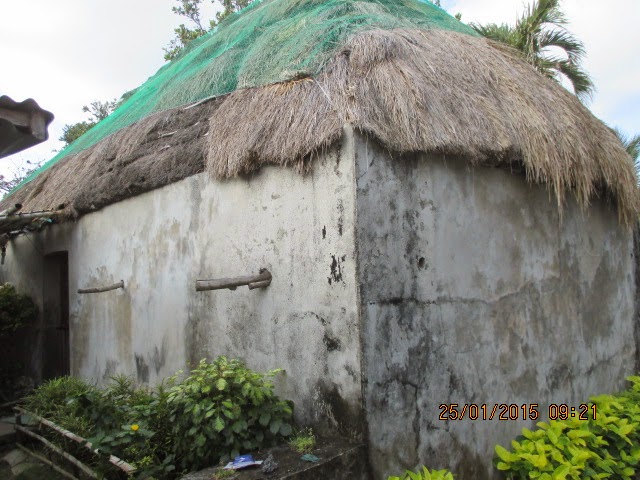Rizal Philippines | January 31, 2015
Atypical 2 storey Ivatan house near the church at Savidug
It is 3 days now and I am not finished posting/reporting the travel we had in Batanes for 4 nights and 5 days. I must have taken 500+ pictures. Thrice, my camera battery went dead.
The following are pictures of Ivatan homes, with most of them 80% intact at Sabtang island namely at Savidug and Chavayan communities. There are some at Uyugan, Ivana, and even in Basco.
Chavayan and Savidug missed being World Heritage spot because there were many homes that were remodelled.
At Savidug
See the smooth wall with lime mortar
Trying gimmick shot; the ceiling/roof is low
The last typhoon did the roof down
The roof is protected by net to prevent wind and birds from destroying the same.
The cogon roof
The Ivatan homes alley is lined up with electric poles
Ivatan house with broken window; no plaster
x
Ivatan row houses?
Broken homes; no roof
With cobblestone alley, this could pass off as World Heritage site.
Colorful window but is an NFA outlet
2 aguas
Cuatro aguas
Jorgeusbiker photo standing in a window
Interior of an Ivatan house; note the reed ceiling; the rafter is typical of all the house design and used in the airport and church ceiling
The CR is modern; the door is solid narra
At Chavayan community
The welcome plaza; the high hills tower over the Ivatan homes
Chavayan is at the southern tip of Sabtang island
Ivatan house made of Cogon all the way
A cogonroofed waiting/meeting area.
Most though have electricity and modern appliances.
A typical Ivatan house is:
1. made of boulders and plastered by cooked lime;
2. the roofing is made of cogon and could be at least a foot thick; the modern ones are held together by net. The cogon grass could last for 25 years (according to the travel guide)
3. there are 2 aguas type (sinadpuhan) and cuatro aguas type (maytuab)
The ceiling is lined up with reeds (vaunuy) which is copied in the Basco airport, and churches. This cools the inside of the house. (which are low ceilinged. The low house profile is a protection from typhoon (which are mostly super) and earthquakes (Iraya is a volcano). You can see in rock formations that there are tectonics rumblings in the island.
Houses and other structures are built on a bayanihan system. Nobody gets paid; the obligor butchers pig or cattle as a gratitude to those who helped. One who does not help can not expect to be helped in the future.
Since the govt can not be relied upon on some of the communal projects, many get things done this way.
The oldest Ivatan house - Dakay house
Jorgeusbiker near the door of the Dakay house
The rafter with grass reeds ceiling insulator
An old singer sewing machine is the appliance inside the old house
Postcard picture perfect shot of the Dakay house
The oldest Ivatan house is the Dakay house in Ivana (it should be called Estrella house since the owner is now surnamed Estrella)
There are many buildings in Basco that are remodelled from original Ivatan homes design. The Batanes hotel wall drew inspiration from the Ivatan house design
Even church interior use the grass reed design
The airport ceiling is Ivatan house inspired
The Batanes Resort
Most communities have traditional Ivatan homes
This is in Ivana
Ivatan house at downtown Basco
Still in Basco
The Rakay house is of Ivatan design





































No comments:
Post a Comment